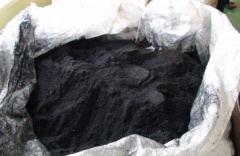Carbon Black
| Infobox on Carbon Black | |
|---|---|
| Example of Carbon Black |  |
| Facts | |
| Origin | - |
| Stowage factor (in m3/t) | 1,67 m3/t (bags) |
| Humidity / moisture | - |
| Ventilation | - |
| Risk factors | See text |
Carbon Black
Description
A sooty substance liable to spontaneous combustion packed in bags, cartons or drums.
Carbon black (also known as acetylene black, channel black, furnace black, lamp black or thermal black) is a material produced by the incomplete combustion of heavy petroleum products such as FCC tar, Coal Tar, ethylene cracking tar, and a small amount from vegetable oil. Carbon black is a form of amorphous carbon that has a high surface-area-to-volume ratio, although its surface-area-to-volume ratio is low compared to that of Activated Carbon. It is dissimilar to soot in its much higher surface-area-to-volume ratio and significantly lower (negligible and non-bioavailable) PAH (polycyclic aromatic hydrocarbon) content.
When offered for shipment in bulk in containers, due consideration must be given to the risks of container contamination and the attendant cleaning costs. Special stowage instructions apply including the fitting of an inner liner which sheathes all surfaces within the container. Spillage and contamination to be avoided. Cleaning possibilities very poor.
Application
Carbon black is used as a filler and reinforcing agent in plastic and rubber products. Extremely fine smoke-like powder which remains suspended in air and penetrates thin paper or textiles.
Carbon black is also widely used as a model compound for diesel soot for diesel oxidation experiments.
The most common use (70%) of carbon black is as a pigment and reinforcing phase in automobile tires. Carbon black also helps conduct heat away from the tread and belt area of the tire, reducing thermal damage and increasing tire life. Carbon black particles are also employed in some radar absorbent materials and in photocopier and laser printer toner.
The balance is mainly used as a pigment in inks, coatings and plastics. For example, it is added to polypropylene because it absorbs ultraviolet radiation, which otherwise causes the material to degrade.
Shipment / Storage
When offered for shipment in bulk in containers, due consideration must be given to the risks of container contamination and the attendant cleaning costs. Special stowage instructions apply including the fitting of an inner liner which sheathes all surfaces within the container. Spillage and contamination to be avoided. Cleaning possibilities are very poor. Finely divided powder is spontaneously combustible.
Risk factors
Reference is made to the relevant IMO publications of hazardous cargo and applicable MSDS sheet(s).
The current International Agency for Research on Cancer (IARC) evaluation is that, "Carbon black is possibly carcinogenic to humans (Group 2B)". Short-term exposure to high concentrations of carbon black dust may produce discomfort to the upper respiratory tract, through mechanical irritation.
Certain types of Carbon black are not subject to the provisions of the IMDG books if they pass the self-heating test described in the Code. They should be certified as such and a copy of
the test certificate should accompany the cargo.











